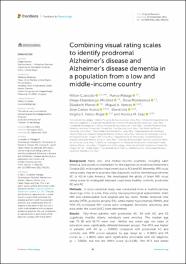Combining visual rating scales to identify prodromal Alzheimer's disease and Alzheimer's disease dementia in a population from a low and middle-income country

View/
Download
(application/pdf: 935.4Kb)
(application/pdf: 935.4Kb)
Date
2022-09-01Author(s)
Custodio, Nilton
Malaga, Marco
Chambergo-Michilot, Diego
Montesinos, Rosa
Moron, Elizabeth
Vences, Miguel A.
Huilca , José Carlos
Lira, David
Failoc-Rojas, Virgilio E.
Diaz, Monica M.
Metadata
Show full item recordAbstract
“Background: Many low- and middle-income countries, including Latin America, lack access to biomarkers for the diagnosis of prodromal Alzheimer's Disease (AD; mild cognitive impairment due to AD) and AD dementia. MRI visual rating scales may serve as an ancillary diagnostic tool for identifying prodromal AD or AD in Latin America. We investigated the ability of brain MRI visual rating scales to distinguish between cognitively healthy controls, prodromal AD and AD.
Methods: A cross-sectional study was conducted from a multidisciplinary neurology clinic in Lima, Peru using neuropsychological assessments, brain MRI and cerebrospinal fluid amyloid and tau levels. Medial temporal lobe atrophy (MTA), posterior atrophy (PA), white matter hyperintensity (WMH), and MTA+PA composite MRI scores were compared. Sensitivity, specificity, and area under the curve (AUC) were determined.
Results: Fifty-three patients with prodromal AD, 69 with AD, and 63 cognitively healthy elderly individuals were enrolled. The median age was 75 (8) and 42.7% were men. Neither sex, mean age, nor years of education were significantly different between groups. The MTA was higher in patients with AD (p < 0.0001) compared with prodromal AD and controls, and MTA scores adjusted by age range (p < 0.0001) and PA scores (p < 0.0001) were each significantly associated with AD diagnosis (p < 0.0001) but not the WMH score (p=0.426). The MTA had better performance among ages <75 years (AUC 0.90 [0.85–0.95]), while adjusted MTA+PA scores performed better among ages>75 years (AUC 0.85 [0.79–0.92]). For AD diagnosis, MTA+PA had the best performance (AUC 1.00) for all age groups.
Conclusions: Combining MTA and PA scores demonstrates greater discriminative ability to differentiate controls from prodromal AD and AD, highlighting the diagnostic value of visual rating scales in daily clinical practice, particularly in Latin America where access to advanced neuroimaging and CSF biomarkers is limited in the clinical setting.“
Collections
- Web of Science (WOS) [236]

